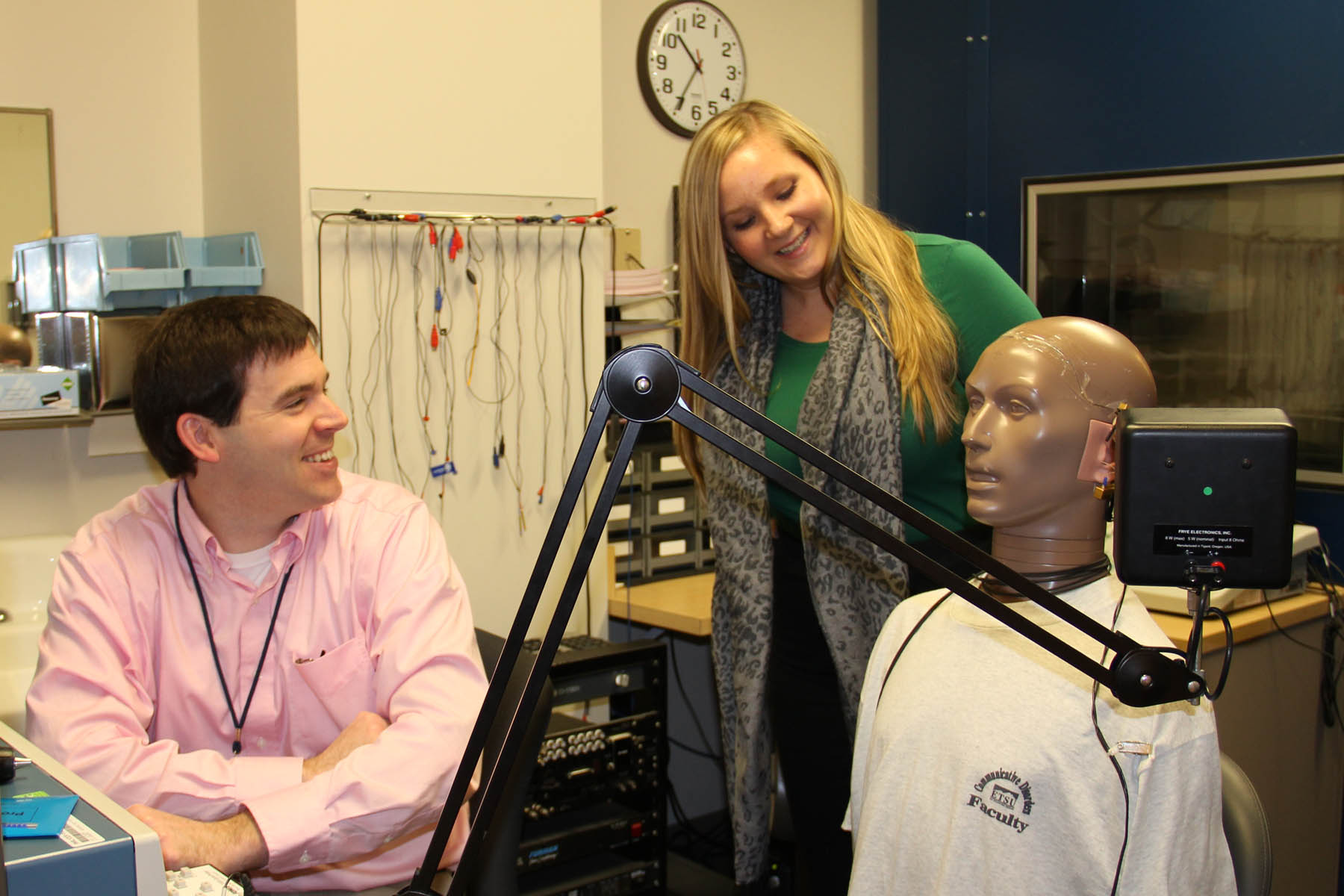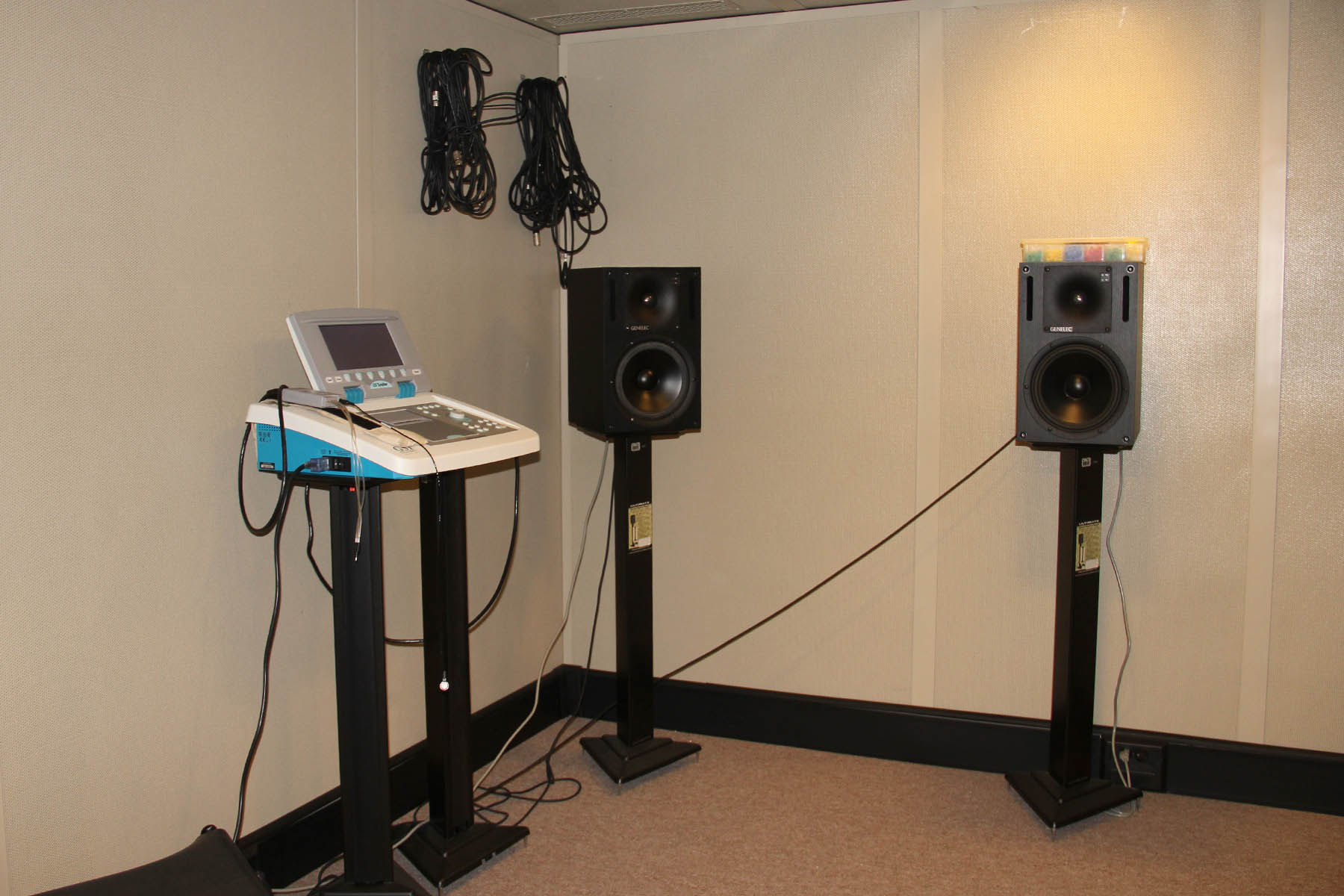The Hearing Aid Research Laboratory is housed at the James H. Quillen VAMC. The Hearing Aid Research Laboratory receives support from the Rehabilitation Research and Development (RR&D) Service, Department of Veterans Affairs via the Auditory and Vestibular Dysfunction Research Enhancement Award Program grant and a RR&D funded Career Development Award.


-
People
Director: Earl Johnson, Au.D., Ph.D.
Au.D. Students:
- Christine Brown
- Jennifer Trammell
- Keri Light
- Amelia Kirbo
-
Research Projects and Current Funding
Funded Research May 2010-April 2012:
Career Development Award-1, U.S. Department of Veterans Affairs
Rehabilitation Research and Development Mentors: Richard Wilson, Ph.D., Harvey Dillon, Ph.D., and Todd Ricketts, Ph.D.
Title: Recommended Targets for Hearing Aids: Extending High- Frequency Bandwidth
Time period: 2 years - $239,920
Project ID: D7336-MNon-Funded Research Posters:
Bell, D. Johnson, E.E., Robinson, J., Koder-Carr, K., Oxendine, K., Cox, P., Hensley, L. (2012, March). Hearing aid evaluation clinic systems redesign, 2012 Joint Department of Defense and Veterans Affairs Audiology Conference, Dallas, TX.
Johnson, E.E., Ching, T. Hou, S., Dillon, H., Zhang, V., Burns, L., van Buynder, P., Wong, A., Flynn, C. (2012). A comparison of NAL and DSL prescriptive methods for pediatric hearing aid fittings: Estimates of speech intelligibility, loudness, and safety. International Hearing Aid Research Conference, Lake Tahoe, CA.
-
Current Equipment/Technology
10 X 10 double-wall sound booth and 15 X 10 outside control room
Typical hearing testing equipment including an audiometer, CD player, tympanometer, and otoscope
Two HP Desktop PCs and Dell laptop
MOTU sound mixers and multiple I/O devices,
Tucker Davis Technology RX8 sound processor and PA5 attenuators
KEMAR manikin with a left and right ear IEC 711 microphone,
8 Genelec 1031A bi-amplified, two-way active monitor loudspeaker systems
Real-ear probe microphone equipment including a Frye Fonix 7000, Fonix 8000 and Audiscan Verifit
Etymotic Research(ER)-7C units probe microphones for real-time audio recordings at the eardrum
Headphone output devices including Sennheiser HAD-200, ER-3A for audiometric testing, ER-2 for a flat wide frequency response, and an ER-5 for maximum amplitude output -
Publications/Presentations/Awards
Publications:
Johnson, E. E. (2008). Dispensers give high marks to open-canal mini-BTEs on user benefit. The Hearing Journal, 61(3), 17-22.
Johnson, E. E. (2008). Despite having more advanced features, hearing aids hold line on retail price. The Hearing Journal, 61(4), 42-48.
Johnson, E. E. (2008). Dispensing a hearing aid brand: What's important to audiologists and their individual decision choice? www.AudiologyOnline.com
Johnson, E. E. (2008). Evidence-based hearing aid dispensing: Survey results of exposure and attitudes. Audiology Today, 20(3), 18-20.
Mueller, H. G. and Johnson, E. E. (2008). Hearing aids. In R. Kramer (ed.) Audiology: Science to Practice. San Diego: CA. Plural Publishing.
Ricketts, T. A., Dittberner, B. A., and Johnson, E.E. (2008). High frequency amplification and sound quality in listeners with normal through moderate hearing loss. Journal of Speech Language and Hearing Research, 51(1), 160-172.
Ricketts, T. A., Johnson, E. E., and Federman, J. (2008). Individual differences within and across feedback suppression hearing aids. Journal of the American Academy of Audiology, 19(10), 748-757.
Johnson, E. E., Mueller, H.G., and Ricketts, T. A. (2009). Statistically-derived factors of varied importance to audiologists when making a hearing aid brand preference decision. Journal of the Academy of Audiology, 20(1), 40-48.
Johnson, E. E., Ricketts, T. A., Hornsby, B. W. Y. (2009). The effect of extending high-frequency bandwidth on the Acceptable Noise Level (ANL) of hearing-impaired listeners. International Journal of Audiology, 48(6), 353-362.
Johnson, E. E. and Ricketts, T. A. (2010). Dispensing rates of four common hearing aid product features: Associations with variations in practice among audiologists. Trends in Amplification, 14(1), 12-45.
Johnson, E. E. (2010). Page Ten. How do hearing aid dispensers pick their buying preferences? The Hearing Journal, 63(3), 10-14.
Mueller, H.G., Johnson, E.E., Weber, J. (2010). Fitting hearing aids: A comparison of three pre-fitting speech tests. www.AudiologyOnline.com
Hornsby, B. W. Y., Johnson, E. E., and Picou, E. (In Press). Effects of degree and configuration of hearing loss on the contribution of high- and low- frequency speech information to bilateral speech understanding. Ear and Hearing.
Johnson, E.E. (In Press). Determinants of VA hearing aid brand dispensing by individual audiologists. Journal of Rehabilitation Research and Development.
Johnson, E. E. and Dillon, H.(In Press). A comparison of gain for adults from generic hearing aid prescriptive methods: Impacts on predicted speech intelligibility and loudness. Journal of the American Academy of Audiology
Presentations:
Johnson, E. E. (2008, October). Dispensing a hearing aid brand: What's important to audiologists and their individual decision choice? AudiologyOnline Live International Broadcast.
Johnson, E. E., Ricketts, T. A., and Hornsby, B. W. Y. (2007, March). Effects of extended frequency bandwidth on the acceptable noise level. American Auditory Society, Scottsdale, AZ.
Johnson, E. E., Ricketts, T., Hornsby, B.W.Y., and Federman, J. (2008, June). Digital feedback suppression systems in commercial hearing aids: Assessments of gain margin and sound quality. International Congress of Audiology, Hong Kong.
Keller, E., Johnson, E. E., Noe, C. (2009, April). A comparison of hearing aid drying device technologies. American Academy of Audiology AudiologyNow Conference, Dallas, TX. Student Au.D. Capstone Project Last updated January 31, 2011
Johnson, E.E. (2010, August). A comparison and contrast of the NAL-NL1 and NAL-NL2 methods: Prescribed frequency response, speech intelligibility, and loudness. International Hearing Aid Research Conference, Lake Tahoe, CA.
Johnson, E.E. (2010, October). Personal evaluations of hearing aids by audiologists and their impact on brand dispensing choice. Arkansas Speech-Language Hearing Association (ArkSHA) Convention, Little Rock, AR.
Johnson, E.E. (2010, October). NAL-NL2: The new hearing aid prescriptive technique from Down Under. Arkansas Speech-Language Hearing Association (ArkSHA) Convention, Little Rock, AR.
Johnson, E.E. (2010, May). Dispensing rates of four common hearing aid product features: Associations with variations in practice among audiologists. Audiology Australia XIX National Conference, Sydney, Australia.
Johnson, E. E. and Dillon H. (2011, April). A comparison of gain for adults from generic hearing aid prescriptive methods (i.e., NAL-NL1, NAL-NL2, DSL m[i/o], and CAMEQ2-HF): Impacts on predicted speech intelligibility and loudness. American Academy of Audiology AudiologyNow!, Chicago, IL.
Johnson, E. E. (2011, April). Listening with normal hearing, hearing impairment, and hearing aids: An audiologic perspective. International Listening Association 32nd Annual Conference, Johnson City, TN.
Johnson, E. E. (2011, April). Outperforming the normal hearing listener: Super-listening with a binaural beamforming noise reduction microphone array. International Listening Association 32nd Annual Conference, Johnson City, TN.
Johnson, E. E. and Bell, D. (2011, April). The diagnosis and rehabilitation of listeners with hearing impairment. International Listening Association 32nd Annual Conference, Johnson City, TN.
Awards:
2008 Featured research article for the 2008 Hearing Aids in Review session at American Academy of Audiology AudiologyNow Conference 2010 Featured research article for the 2010 Hearing Aids in Review session at American Academy of Audiology AudiologyNow Conference